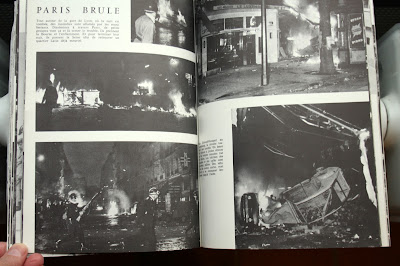Paris a brulé
KAHN Gilbert
Published by Del Duca Paris jour, Paris, 1968
EDITION ORIGINALE de ce recueil de photos paru 1 mois après les évènements de mai 68 qui firent trembler la capitale. Commentaires et nombreuses imges en noir de Pierre Juillet, Christian Joubert et Michel Hermans.
THE PROTEST PHOTOBOOK 1956 – 2013
CURATED BY MARTIN PARR - TEXTS BY GERRY BADGER
This modest exhibition briefly explores a highly interesting yet neglected area of the photobook canon – the protest book - particularly from the heyday of protest, the 1960s and 70s.
The generation of protest that emerged after the War was inward-looking and narcissistic in many ways but also idealistic. Many, certainly, were “rebels without a cause”, but others certainly had their causes. They ranged from concern about Afro-American civil rights, American imperialism, colonialism, the capitalist system, nuclear arms, gay and women’s issues.
In the 1960s, the big, worldwide cause was the war in Vietnam, but in essence Vietnam was an umbrella crusade which subsumed many others, some of global significance, others of local interest only. Here, we have books from America championing Civil Rights and condemning the Vietnam War. We have books from Japan examining many aspects of the complex, love- hate relationship between the United States and Japan. We have books from France recording the events of May ’68, from Italy documenting the low-level civil war during the Anni di Piombo (Years of Lead), and from Latin America denouncing “American imperialism”.
From the late 1970s and 80s, there are books from Holland, Germany, and Scandinavia tackling environmental issues, a more recent concern, and we come up to date with books about the “Arab Spring”, the protests demanding change in the Middle East, and also the “Occupy” protests against the excesses of capitalism.
Some of these books were made by renowned photographers, such as Richard Avedon, but many were made by students or anonymous activists caught up in the protests. Some were expensively produced, but most were produced as cheaply as possible. And yet, because protest is essentially about generating freedom, the makers of protest photobooks have often felt free to experiment.
As dissent takes to the Internet, and is spread through Facebook and Twitter, it may be that the “golden age” of protest photobooks is over. However, the Net also allows the cheap printing and dissemination of self-published books, so whenever a photographer has a concern about something and wants to act upon it, the avenue of the protest photobook is certainly open. And there will always be some who will take it, whether to use it as a vehicle for protest in itself, or to document a process of dissent with which they feel passionately involved.




























Geen opmerkingen:
Een reactie posten